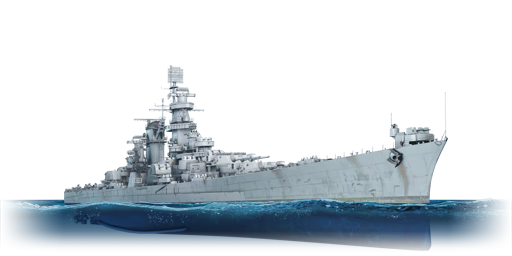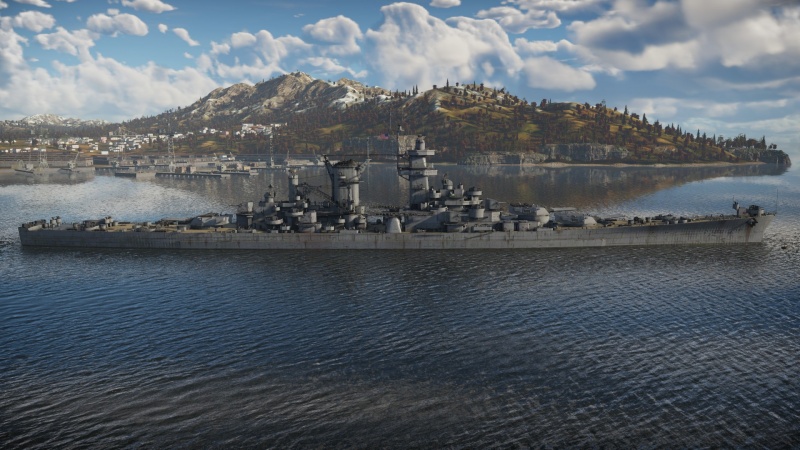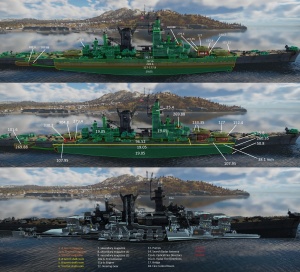USS Alaska
Contents
Description
The Alaska-class, USS Alaska (CB-1), 1944 was the first and last US Navy ship class comissioned as battlecruiser. Alaska was the lead ship of her class, and had two sisters Guam and Hawaii. She was laid down on 17th December 1941 and comissioned on 17th June 1944. The main armament consisted of nine 12 inch/50 Mark 8 guns in triple mounts with two turrets located on bow and one aft. Long range anti-aircraft protection suite was made of twelve 5 inch/38 Mark 12 dual purpouse guns in twin mounts with three turrets on each side of hull. Medium and short range anti-aircraft duties were performed by fourteen 40 mm Bofors L/60 Mark 2 guns mounted in quadruple mounts and thirty-four 20 mm Oerlikon Mk. II autocannons located on various places along the ship. During WWII she participated in Battle of Okinawa which was the only major action she took part in. On 17th February 1947 Alaska was decomissioned. There was some thought given to converting them to missile ships but these plans never happened and Alaska was scrapped in 1960.
Alaska was introduced in Update "Drone Age". She is fast and quite manoeuverable ship, although due to her light armour when compared to for example Scharnhorst-class battlecruiser is no match for battleships in direct encounter. Her magazines located on waterline are prone to fatal explosion due to only 178 mm thick armour protecting these vital areas. Other than that, her guns offer great penetration values and fast reload only offset by quite small explosive charge of only 7.73 kg TNT eq in her Mark 18 APCBC shells.
General info
Survivability and armour
| Armour | Front | Side | Rear | Roof/Deck |
|---|---|---|---|---|
| Main calibre turret | 12.8 inches | 6 inches (front, cheeks) 5.25 inches (rear) |
5.25 inches | 5 inches |
| Auxiliary calibre turret | 1 inch | 0.75 inches | 0.75 inches | 1 inch |
| Barbette | 11 inches (upper) 1.5 inches (lower) |
13 inches (front, upper) 12 inches (rear, upper) 1.5 inches (lower) |
11 inches (upper) 1.5 inches (lower) |
1.9 inches |
| Citadel | 0.62 inches (upper) 10.25 inches (middle) 2 inches (lower) |
1.125 inches (upper) 9 inches (middle) 5-7 inches (lower) 0.75 inches (inner) |
0.62 inches (upper) 10.25 inches (middle) 2 inches (lower) |
1.425 inches (upper) 4.25 inches (middle, magazine) 3.8 inches (middle, machinery) 0.75 inches (lower, magazines only) |
| Bridge | 10.63 inches | 5 inches | ||
Notes:
- The entire superstructure except for the funnel has 0.75 inches of anti-fragmentation armour
Mobility
USS Alaska has an average mobility for a WW2 battlecruiser. Being a heavy ship, captains of Alaska should not expect to stop from flank speed fastly, a process that can take about half a minute. Being a long ship, changing direction will also take some time and captains of Alaska should expect a large turn radius.
| Mobility Characteristics | |||
|---|---|---|---|
| Game Mode | Upgrade Status | Maximum Speed (km/h) | |
| Forward | Reverse | ||
| AB | |||
| Upgraded | 71 | 21 | |
| RB/SB | |||
| Upgraded | 61 | 18 | |
Modifications and economy
Armament
Primary armament
The main armament of the Alaska is composed of a total of 9x 305mm 50-calibre cannons, arranged in three triple turrets with two superfiring fore and one aft. The gun handling is not slow, but not especially fast for the size of the turrets. The maximum reload speed is quite competitive at 20 seconds, though most players of the ship won't have a top level crew and thus will have a somewhat slower reload.
The Alaska has access to two shell types for the main guns.
The armour-piercing shell is the main one you'll use for opposing capital ships and occasionally on cruisers that may have a lot of armour or are angled. The AP shell of the Alaska was designed as a so called 'super-heavy' shell, which means that it has a lot bit more mass than a normal AP shell. This means the shell has less muzzle velocity, intended to give the shells a sharper descent angle when coming down on an opposing vessel, a little like a mortar, with the hopes of going through deck armour, which tends to be relatively thin.
The problem with this is that the US didn't realise that the range needed to have the shells drop at a flat enough angle on the deck to effectively penetrate most deck armour was quite a bit further than you could physically aim with any real accuracy. Even ignoring that, warships in naval battles tend to always want to close the range anyway in order to be able to aim accurately and/or use torpedoes, which would rapidly diminish the possibility of penetrating deck armour. What this means is that you simply cannot use the shells for their intended purpose of hitting deck armour, meanwhile the lower muzzle velocity makes aiming your AP shells more difficult and shells hitting the side of an enemy vessel are at a sharper angle than they would otherwise have been, which makes it unnecessarily harder to penetrate enemy side armour. Not only that but, as is typical for US warships, the AP shell has a relatively poor bursting charge of less than 8kg. However, the shells retain relatively high penetration statistics and so that still remain a threat to other capital ships, if aimed at the right places.
The HE shell of the Alaska is a more normal naval shell and the 35kg of explosive power is fairly decent for its calibre. Although it's not too competitive compared to the real hard hitting HE shells at top tier naval, this shell will still enable you effectively dispatch lightly armoured vessels such as destroyers and small cruisers without difficulty, as well as being able to harass anything on the deck of opposing capital ships.
| Penetration statistics | |||||||
|---|---|---|---|---|---|---|---|
| Ammunition | Type of warhead |
Penetration @ 0° Angle of Attack (mm) | |||||
| 1,000 m | 2,500 m | 5,000 m | 7,500 m | 10,000 m | 15,000 m | ||
| Mk.17 HC | HE | 68 | 68 | 68 | 68 | 68 | 68 |
| Mk.18 AP | APCBC | 621 | 582 | 524 | 475 | 434 | 374 |
| Shell details | ||||||||||||
|---|---|---|---|---|---|---|---|---|---|---|---|---|
| Ammunition | Type of warhead |
Velocity (m/s) |
Projectile mass (kg) |
Fuse delay (s) |
Fuse sensitivity (mm) |
Explosive mass (TNT equivalent) (kg) |
Ricochet | |||||
| 0% | 50% | 100% | ||||||||||
| Mk.17 HC | HE | 808 | 426.38 | 0 | 0.1 | 35.31 | 79° | 80° | 81° | |||
| Mk.18 AP | APCBC | 762 | 517 | 0.035 | 17 | 7.73 | 48° | 63° | 71° | |||
Secondary armament
Some ships are fitted with weapons of various calibres. Secondary armaments are defined as weapons chosen with the control Select secondary weapon. Evaluate the secondary armaments and give advice on how to use them. Describe the ammunition available for the secondary armament. Provide recommendations on how to use them and which ammunition to choose. Remember that any anti-air armament, even heavy calibre weapons, belong in the next section. If there is no secondary armament, remove this section.
| Penetration statistics | |||||||
|---|---|---|---|---|---|---|---|
| Ammunition | Type of warhead |
Penetration @ 0° Angle of Attack (mm) | |||||
| 1,000 m | 2,500 m | 5,000 m | 7,500 m | 10,000 m | 15,000 m | ||
| AAC Mk.34 | HE | 36 | 36 | 36 | 36 | 36 | 36 |
| Common Mk.32 | Common | 124 | 103 | 77 | 58 | 46 | 37 |
| SP Common Mk.46 | SP Common | 150 | 125 | 93 | 71 | 56 | 45 |
| AAVT Mk.31 | HE-VT | 36 | 36 | 36 | 36 | 36 | 36 |
| Shell details | ||||||||||||
|---|---|---|---|---|---|---|---|---|---|---|---|---|
| Ammunition | Type of warhead |
Velocity (m/s) |
Projectile mass (kg) |
Fuse delay (s) |
Fuse sensitivity (mm) |
Explosive mass (TNT equivalent) (g) |
Ricochet | |||||
| 0% | 50% | 100% | ||||||||||
| AAC Mk.34 | HE | 792 | 25 | 0 | 0.1 | 3,220 | 79° | 80° | 81° | |||
| Common Mk.32 | Common | 792 | 24.49 | 0.01 | 6 | 1,150 | 47° | 60° | 65° | |||
| SP Common Mk.46 | SP Common | 792 | 25 | 0.01 | 6 | 906.5 | 48° | 63° | 71° | |||
| Proximity-fused shell details | ||||||||||||
|---|---|---|---|---|---|---|---|---|---|---|---|---|
| Ammunition | Type of warhead |
Velocity (m/s) |
Projectile mass (kg) |
Fuse delay (s) |
Fuse sensitivity (mm) |
Arming distance (m) |
Trigger radius (m) |
Explosive mass (TNT equivalent) (g) |
Ricochet | |||
| 0% | 50% | 100% | ||||||||||
| AAVT Mk.31 | HE-VT | 792 | 25 | 0 | 0.1 | 457 | 23 | 3,220 | 79° | 80° | 81° | |
Anti-aircraft armament
An important part of the ship's armament responsible for air defence. Anti-aircraft armament is defined by the weapon chosen with the control Select anti-aircraft weapons. Talk about the ship's anti-air cannons and machine guns, the number of guns and their positions, their effective range, and about their overall effectiveness – including against surface targets. If there are no anti-aircraft armaments, remove this section.
Scout plane
Located midships are two catapults with one OS2U-1 scout plane each which provide unique offensive and defensive abilities, expanding tactical options. Ship-launched scout planes fly just like regular tree units but lack munition choices and cockpit views. Alongside the typical abilities of strafing, dropping 2 x 100 lb bombs, and capturing zones, the OS2U-1 and other scout planes have the added ability to lay down smoke cover (up to 3 times). Captains will be wise to remember to utilize the aircraft and consider when best to use it, for example to cap a point early or late in the match, to create a smoke screen to stymie enemy bombardment and repair, to attack enemy units directly, or perhaps something completely new! With two scout planes one can risk a cap attempt at the beginning of the match, saving the second for any opportunity that presents itself.
Usage in battles
Alaska is a versatile warrior capable of achieving multiple objectives. However, its generally unwise to spawn Alaska as your first ship (unless you are in a tight squad) and here are the main reasons: First, you have to face the most intense early-game combat and may not spare focus to do multi-tasking. Second, Alaska's low damage output won't help you and your teammate win the early fight. Third, Alaska is tanky indeed but to absorb damage in this ship is the least optimal use and Arizona suits this role much better than her.
After securing the early game, you may spawn Alaska as your second ship and pursue for the mid-late game. Depending on the situation, you may chase down weakened opposing capital ships; sail straight towards one objective and secure the others with your floatplane; repel air raid and deny irregular motorboat tactics with your powerful autocannon arrays. Eventually, you will claim a victory in this ship.
Pros and cons
Pros:
- Good survivability
- Excellent top speed and manoeuvrable
- Massive amount of AA defenses
- Two scout seaplanes
Cons:
- Full potential is locked behind high tier modifications (max top speed and floatplanes), stock ship is hardship
- Low damage output, she has difficulties in securing kills
- One deadly weak spot above waterline
History
Describe the history of the creation and combat usage of the ship in more detail than in the introduction. If the historical reference turns out to be too long, take it to a separate article, taking a link to the article about the ship and adding a block "/History" (example: https://wiki.warthunder.com/(Ship-name)/History) and add a link to it here using the main template. Be sure to reference text and sources by using <ref></ref>, as well as adding them at the end of the article with <references />. This section may also include the ship's dev blog entry (if applicable) and the in-game encyclopedia description (under === In-game description ===, also if applicable).
Media
- Skins
See also
Links to articles on the War Thunder Wiki that you think will be useful for the reader, for example:
- reference to the series of the ship;
- links to approximate analogues of other nations and research trees.
External links
| New York Shipbuilding Corporation | |
|---|---|
| Gun Destroyers (DD) | |
| Porter-class | USS Porter |
| Cruiser, Light (CL) | |
| Cleveland-class | USS Cleveland |
| Fargo-class | USS Fargo |
| Worcester-class | USS Roanoke |
| Large Cruisers (CB) | |
| Alaska-class | USS Alaska |
| Battleships (BB) | |
| Wyoming-class | USS Arkansas |
| USA battlecruisers | |
|---|---|
| Alaska-class | USS Alaska |






